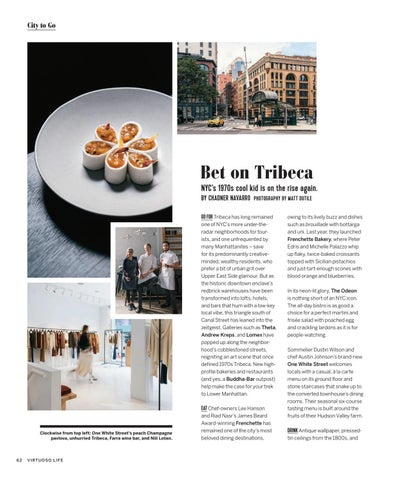City to Go
Bet on Tribeca NYC’s 1970s cool kid is on the rise again. BY CHADNER NAVARRO PHOTOGRAPHY BY MATT DUTILE GO FOR Tribeca has long remained one of NYC’s more under-theradar neighborhoods for tourists, and one unfrequented by many Manhattanites – save for its predominantly creativeminded, wealthy residents, who prefer a bit of urban grit over Upper East Side glamour. But as the historic downtown enclave’s redbrick warehouses have been transformed into lofts, hotels, and bars that hum with a low-key local vibe, this triangle south of Canal Street has leaned into the zeitgeist. Galleries such as Theta, Andrew Kreps, and Lomex have popped up along the neighborhood’s cobblestoned streets, reigniting an art scene that once defined 1970s Tribeca. New highprofile bakeries and restaurants (and yes, a Buddha-Bar outpost) help make the case for your trek to Lower Manhattan.
Clockwise from top left: One White Street’s peach Champagne pavlova, unhurried Tribeca, Farra wine bar, and Nili Lotan.
62
V I RT U O S O L I F E
EAT Chef-owners Lee Hanson and Riad Nasr’s James Beard Award-winning Frenchette has remained one of the city’s most beloved dining destinations,
owing to its lively buzz and dishes such as brouillade with bottarga and uni. Last year, they launched Frenchette Bakery, where Peter Edris and Michelle Palazzo whip up flaky, twice-baked croissants topped with Sicilian pistachios and just-tart-enough scones with blood orange and blueberries. In its neon-lit glory, The Odeon is nothing short of an NYC icon. The all-day bistro is as good a choice for a perfect martini and frisée salad with poached egg and crackling lardons as it is for people-watching. Sommelier Dustin Wilson and chef Austin Johnson’s brand-new One White Street welcomes locals with a casual, à la carte menu on its ground floor and stone staircases that snake up to the converted townhouse’s dining rooms. Their seasonal six-course tasting menu is built around the fruits of their Hudson Valley farm.
DRINK Antique wallpaper, pressedtin ceilings from the 1800s, and













